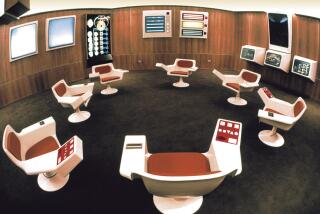Book Review : The Trigger Finger and the Computer
- Share via
Computers in Battle: Will They Work?, edited by David Bellin and Gary Chapman (Harcourt Brace Jovanovich: $14.95; 362 pages)
No computer program works right the first time. There are always bugs, either because of mistakes in conception or execution or simply because of typographical errors. These bugs become apparent only after the program is used, and frequently they do not become apparent right away.
Sometimes the bugs cause the system to stop working completely, and sometimes they cause it to do things that are unexpected and wrong. Either way, actual use of a computer program under real conditions is the only way to find these bugs and to correct them.
This basic fact about computers--which is well known to everyone who has installed a new program for business or home use--causes many computer experts to conclude that President Reagan’s Strategic Defense Initiative cannot work.
The space-based shield against incoming Soviet warheads must be directed by the largest and most complicated computer program ever written. It has been estimated that the Star Wars program will have to contain between 10 million and 100 million lines of code. By comparison, a standard word-processing program contains about 10,000 lines of code, and the space shuttle’s computer program contains about 100,000 lines of code.
No Way to Test It
The trouble is, there is no conceivable way to fully test the Star Wars program short of starting a nuclear war, which even its most avid supporters do not propose. Nonetheless, for Star Wars to work, it has to work right the first time, and everyone, friend and foe, has to believe that it will.
This fatal flaw in the Strategic Defense Initiative has been brooded about and written about for some time now, and it is a central theme of “Computers in Battle: Will They Work?” The book is a collection of 11 essays by various authors, almost all of whom are computer scientists and all of whom oppose the increasing computerization of the nation’s military force. Their unanimous answer to the question of the title (“Will They Work?”) is: No.
“Given the unprecedented complexity of the problem and the fact that the system can never be tested under the conditions it would face in an actual nuclear attack, we believe that it will be impossible to trust a deployed SDI system,” two computer scientists, Eric Roberts and Steve Berlin, write in one of the essays.
“To be at all confident of the reliability of complex systems, there must be a period of testing under conditions of actual use,” writes Alan Borning, another computer scientist, in another of the essays. “Simulations, analyses of possible modes of failure, and the like can each expose some problems, but all such tests are limited by the fact that the designers test for exactly those circumstances that they anticipate may occur.”
A Must in the Pentagon
But there is more to the book than a simple restatement of the problem of testing the computer program for SDI. The computer has become as important to the Pentagon as any other piece of technology. The modern army and modern weapons could not function without it, with the result that the Defense Department today pays for nearly three-fourths of all academic research in computer science.
“Aside from astronautical and electrical engineering, computer science is the only field dominated by military funding,” writes Clark Thomborson, another computer scientist.
This state of affairs worries all of the contributors to this volume. They argue that the Pentagon has placed too much faith in computers, which cannot meet the grandiose goals of military planners in the first place and shouldn’t be allowed to even if they could.
The book correctly pooh-poohs the notion that artificial intelligence is going to produce weapons that think for themselves, and it raises serious and troubling questions about overconfidence in a wide variety of systems based on computers that are unlikely to work right under wartime conditions.
What’s more, several of the authors argue that it is a fundamental conceptual mistake to attempt to computerize war, which, they say, is inherently unpredictable and unquantifiable. There is a mismatch between the computer’s strengths and the demands of a military operation.
A Stinging Criticism
“Humans inhabit an unstructured world of goals, actions, and chance events,” writes Tom Athanasiou. “Machines are trapped in tidy space of number, fact, and logic. They can never know the real physical and social world of accidents, tensions, and battlefield chaos. They cannot reason about the nature, purpose, and destination of previously unknown objects, nor can they reason about the intentions of an adversary. They can’t use analogy to adapt existing plans to new situations.”
“Computers in Battle” presents a detailed overview and stinging criticism of the Pentagon’s top-to-bottom reliance on computers. Almost all of the authors are associated with Computer Professionals for Social Responsibility, an organization that seeks peace through disarmament, and this book is their manifesto.






